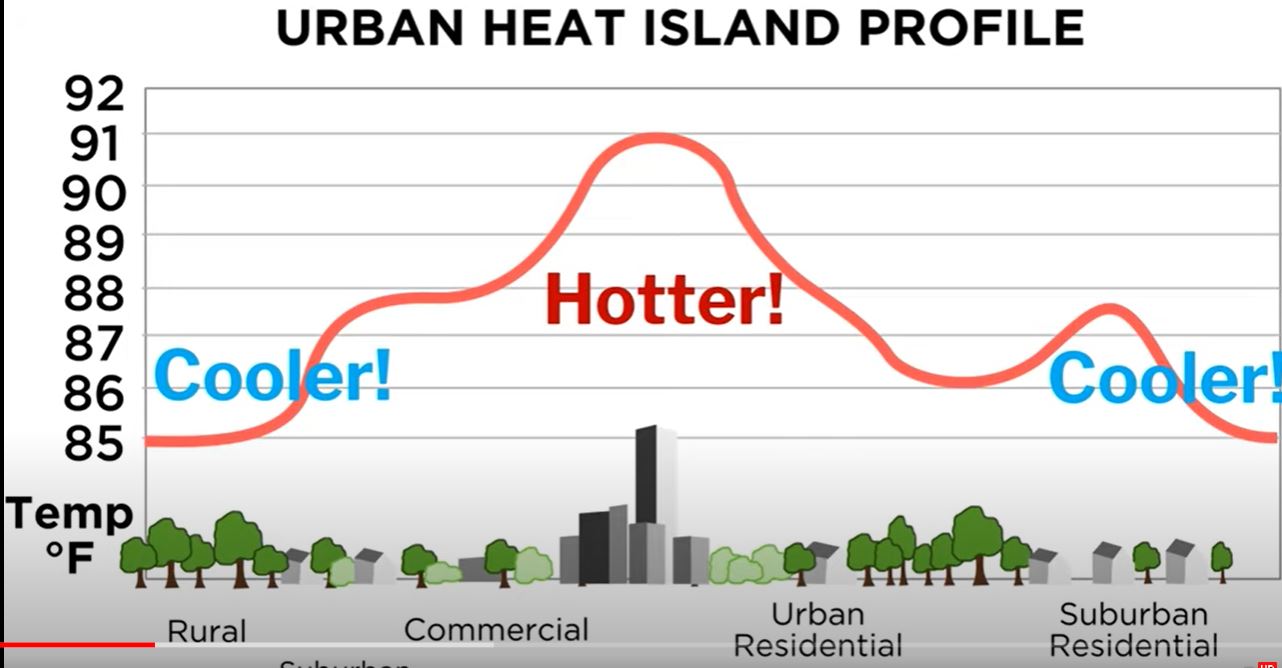Also, Mr. Di Liberto, who Mr. Riemer mis-spoke by saying he was ‘head’ of climate.gov (but who is not head but is a social media manager for NOAA's Climate.gov) uses this term himself. Just because people stand in the shade of a building vs. in an unshaded area doesn’t mean the building (and all the pavement and concrete surrounding the building) isn’t absorbing heat. It is a scientific fact that urban areas are just plain hotter.
If there were shade trees to stand under, people would stand there instead of on the sidewalk in the shadow of a building.
There are ways to attempt to reduce UHI effect of tall buildings. We can and should discuss those. The most obvious is to increase tree cover, preserve or create vegetation, deploy green roofs, limit paved ares, and use reflective surfaces. In fact, Cambridge, MA is considering adopting a Cool Factor Zoning ordinance!
One of the best ways to implement a climate-resilient THRIVE 2050, climate resilient Master Plans, and adopt County policies that actually improve resilience is the expand forests, tree canopy, green infrastructure as well as addressing the building envelopes and exteriors. This requires an all-in approach, not half measures that misrepresent what we are dealing with.
Thank you - I assume you will put the word URBAN heat island effect back into Thrive 2050 and all other policies and ordinances.
To underscore these FACTS, here are some references:
NOAA
Mr Di Liberto on URBAN heat islands: https://youtu.be/sXtjMcOTIzg
Heat.gov: https://www.heat.gov/pages/urban-heat-islands
U.S Global Change Research Program National Climate Assessment
https://nca2018.globalchange.gov/chapter/11/
See chapter 11
"Despite these differences, U.S. cities experience some climate impacts in similar ways. For example, prolonged periods of high heat affect urban areas around the country.21 Cities are already subject to higher surface temperatures because of the island (UHI) effect, which can also affect regional climate.29 The UHI is projected to get stronger with climate change.29 Another commonality is that most cities are subject to more than one climate stressor. Exposure to multiple climate impacts at once affects multiple urban sectors, and the results can be devastating.30 “
https://nca2018.globalchange.gov/chapter/18/
See chapter 18
"Northeastern cities, with their abundance of concrete and asphalt and relative lack of vegetation, tend to have higher temperatures than surrounding regions due to the urban heat island effect (increased temperatures, typically measured during overnight periods, in highly urbanized areas in comparison to outlying suburban, exurban, and rural locations). During extreme heat events, nighttime temperatures in the region’s big cities are generally several degrees higher than surrounding regions, leading to higher risk of heat-related death. In urban areas, the hottest days in the Northeast are also often associated with high concentrations of urban air pollutants including ground-level ozone (Ch. 13: Air Quality, KM 1). This combination of heat stress and poor urban air quality can pose a major health risk to vulnerable groups: young children, elderly, socially or linguistically isolated, economically disadvantaged, and those with preexisting health conditions, including asthma. Vulnerability is further heightened as key infrastructure, including electricity for air conditioning, is more likely to fail precisely when it is most needed—when demand exceeds available supply—with the potential for substantial negative health consequences.287 Finally, vulnerability to heat waves is not evenly distributed throughout the region. Rather, outdoor versus indoor air temperatures, baseline health, occupation, and access to air conditioning are important determinants of vulnerability (see Key Message 4).”
…"Present-day high temperatures (heat) have been conclusively linked to a higher risk of illness and death, particularly among older adults, pregnant women, and children (Ch. 14: Human Health). A number of studies have replicated these findings specifically in the Northeast (see Box 18.3; e.g., Wellenius et al. 2017, Bobb et al. 2014, Hondula et al. 2012305,306,307). Ambient temperatures and heat-related health effects can vary significantly over small geographic areas due to local land cover (for example, due to the urban heat island effect; see Key Message 3) (see also Ch. 5: Land Changes, KM 1), topography, and the resilience of individuals and communities.307,308"
U.S. Environmental Protection Agency
https://www.epa.gov/sites/default/files/2017-05/documents/reducing_urban_heat_islands_ch_6.pdf
https://www.epa.gov/heatislands/learn-about-heat-islands
NASA
https://climatekids.nasa.gov/heat-islands/
University Consortium for Atmospheric Research (UCAR)
https://scied.ucar.edu/learning-zone/climate-change-impacts/urban-heat-islands
Now, if you want to discuss how to mitigate the UHI effect of tall buildings, we can start talking about these types of actions:
https://www.cambridgema.gov/CDD/Projects/Zoning/climateresiliencezoning
https://www.epa.gov/heatislands/heat-island-cooling-strategies
https://climate.mit.edu/explainers/urban-heat-islands
https://urbanland.uli.org/sustainability/four-approaches-to-reducing-the-urban-heat-island-effect/
https://earthbound.report/2021/07/14/5-ways-to-reduce-the-urban-heat-island-effect/








